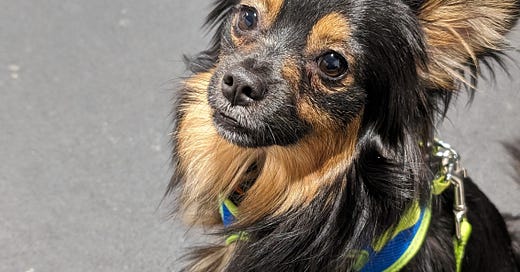Start simple, get fancy later.
I could go so many places with this one, but for this week I’ll relate it to training your dog.
It’s really easy to get caught up in the hot shot dogs of the socials. Intense dogs trained into perfect heels. Sports stars flying over their owners to catch a disc (basically a fancy Frisbee). Aqua dogs sailing through the air off of a dock after a float toy to land somewhat gracefully in a pool of water. Agility dogs shooting through tunnels and leaping through hoops. Even what seems like the basic house pet, flowing easily from one command to the next, waiting patiently to be rewarded when they complete their tasks.
You look at your couch potato pup who barely knows sit and feel like you could never compete.
Here’s the great news - you don’t have to. How your dog is trained, and in what skills, is up to you.
And let me tell you a secret - some of those super trained dogs aren’t that well trained in the basics. This is perfectly ok.
While those videos are fun to watch, training your dog in the skills you feel are necessary to fit your life should really be the first step.
Start small with basic skills. Maybe it’s sit and down or shake and roll over. I like to use at least two skills because dogs do get bored and if you’re only working on one thing over and over the session may go sideways quickly.
Plan to keep your sessions short to start, even if you feel like they’re not successful. Add a little play in between your skills work to keep it fun and help with engagement. I’m talking 5 minutes tops. Again, boredom will set in.
Celebrate the hell out of your dog any time they hit the skill. Treats. “Yes!” (Or whatever your marker word is.) Lots of pets. Let that dog know they knocked it out of the park. Getting a sit on command may feel like nothing to celebrate when other dogs are out there flying through the air, but for a dog and guardian who have never accomplished it before it absolutely is.
Keep in mind that what’s simple for one dog may not be for others. It took me much longer to train Archie to sit than it did any other dog. He could down like a rockstar, but when I tried to lure him into a sit he would just turn in circles. When we finally got there, it felt like a major accomplishment.
Starting small with your training (and remaining consistent with it) will also help you learn what other skills your dog is good at. It will allow you to build the foundation that may lead to more advanced training or skills. You may also find that incorporating some of those other skills helps enhance your basic training.
Cola, for example, loves to sniff things out. Giving her the opportunity to find treats or targets between reps of some of the basics kept her motivated and more willing to come back and work. That turned into taking some nose work classes where she wasn’t expected to have perfect obedience skills mastered.
Those classes also helped improve our dog/handler relationship significantly. Here’s a quick video of us learning together in my backyard (it’s definitely not perfect and this is pretty intro level nose work training). If you watch it with sound on, you’ll hear dogs barking in the background. She would not have this level of attention for basics.
We never would have gotten there had we not even started with the small stuff.
Start as small as you need to. You’ll get to the fancy stuff if and when you decide it’s right for you and your dog.
Love and tail wags,
Mary-Agnes





